Family : Squatinidae

Text © Giuseppe Mazza

English translation by Mario Beltramini
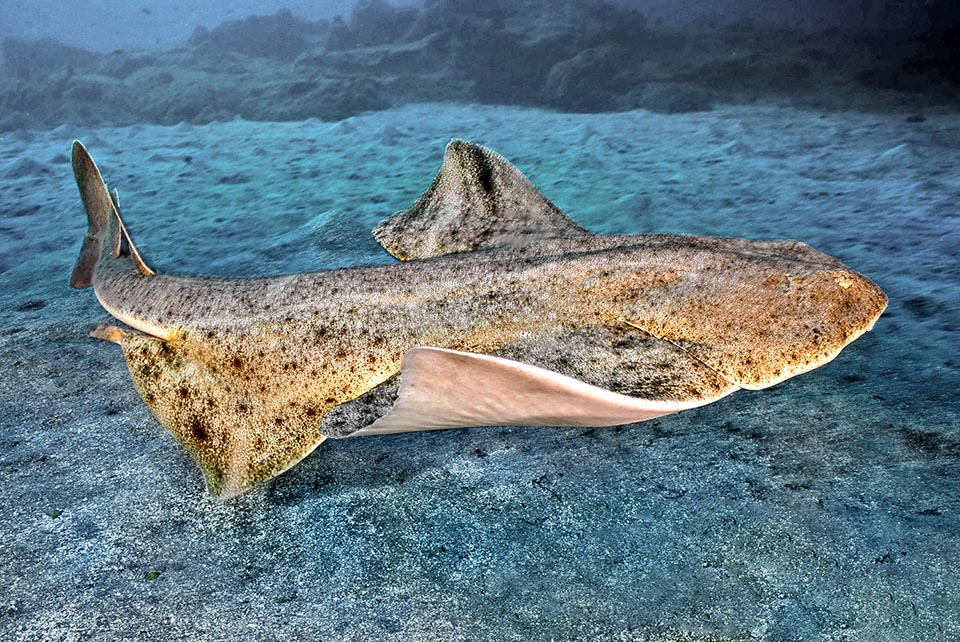
Present in Mediterranean and in Black Sea, the Angelshark lives also along the eastern Atlantic coast, from Shetland Islands to the Canaries and Morocco © Michael J Sealey
Angelic, but not too much because of its voraciousness, the Angelshark [Squatina squatina (Linnaeus 1758)] owes its vulgar name to the big pectoral fins like wings that at the same time justify the title of shark, because, unlike rays, they are fused to the body not to the head. Consequently, it belongs to the order Squatiniformes and to the Squatinidae, family of ancient lineage, born in the Late Jurassic and represented nowadays, in 2022, only by the genus Squatina with 26 species.
This term, repeated also for the species, is the vulgar name used by Romans for the Angelfish and the rays starting from the Latin term “squama” = squama, due to the square shape like a scale of the first half of the body seen from above, and in fact among the Italian fishermen also circulates the name of “Squadro” or “Squadro Fish”.
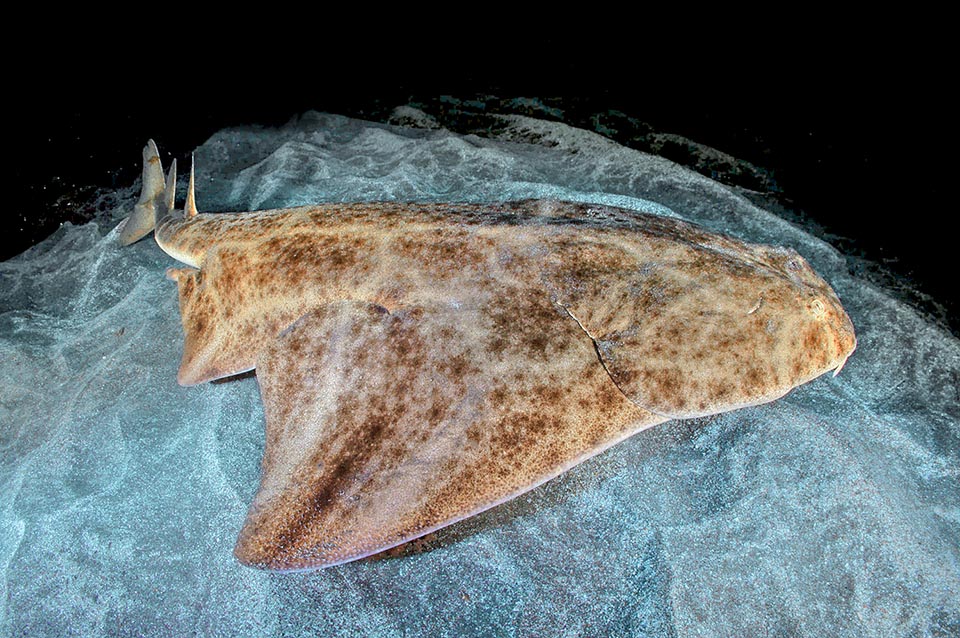
Owes the common name to the big pectoral fins, like wings, and is considered a shark as these, unlike the rays, depart from the body and are not fused to the head © Michael J Sealey
Conversely, among their French colleagues, the angelic look did prevail, so much that the famous “Bay of Angels”, between Cap d’Antibes and Nice airport, gets the name from this fish, once very abundant in their nets.
Zoogeography
Squatina squatina is present in the north-eastern side of the Atlantic, from the Shetland Islands and the southern part of the Scandinavian peninsula up to the Canary Islands and Morocco coasts. Across Gibraltar Strait, it has colonized also the Mediterranean and the Black Sea.
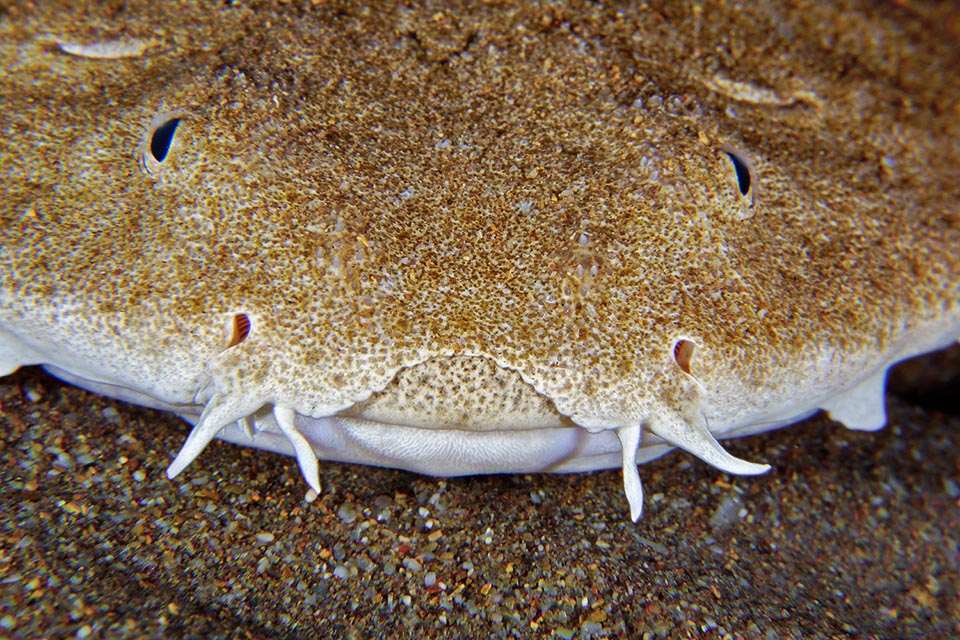
Squatina squatina snout close-up. Over the huge mouth, with 20 sharp small teeth per jaw, we note the nares close to the barbels. After the small eyes, up, are visible two big half-moon shaped spiracles that pump water on the gills when the fish is resting motionless on the seabed, covered by sand or by mud © Jaime E. Rodríguez Riesco
Ecology-Habitat
The Angelshark is a demersal fish living along the coasts and the continental shelves between 5 and 50 m of depth penetrating at times even the brackish waters of the estuaries.
It loves the temperatures between 7,7 and 19,4 °C, and even if it swims in rocky environments, it prefers the muddy or sandy bottoms where it can bury and rests during the day allowing only the eyes to protrude for possibly catching, overtime, the unfortunate passing-by fishes that it swallows, like the European angler (Lophius piscatorius), by opening in a click the huge mouth.
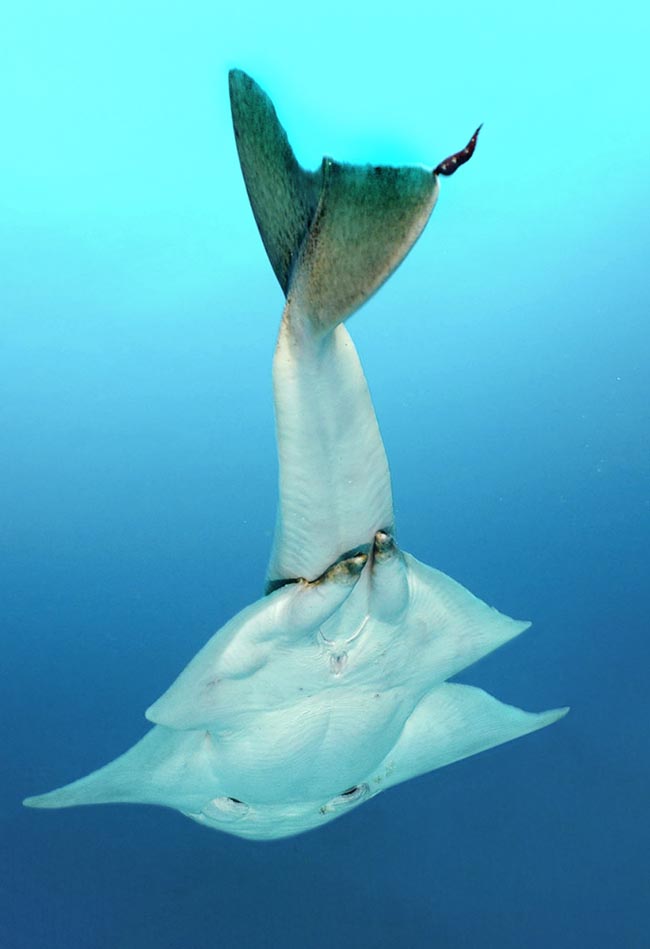
Unlike analogous species, the pale ventral side is mainly covered by a milling with small and rounded denticles. The pelvic fins, they too open as if they were wings, have in the adult males two calcified pterygopodia that convey the sperm. On caudal fin we note a Stibarobdella macrothela, a leech often present on these sharks © Michael J Sealey
During the night it also moves offshore looking for prey it locates using, like other sharks, the Ampullae of Lorenzini that detect their magnetic fields.
In winter it lives in deep waters, in spring it gets up and in summer it often migrates northwards where the water is cooler.
Morphophysiology
The maximum recorded size is of 244 cm and 80 kg, whilst the current one is of about 150 cm.
The dorso-ventrally flattened body is very broad in the front to then get thinner towards the tail.
An important diagnostic character that distinguishes it from similar species is the milling that here, besides covering the upper part of the body extends also over a large part of the ventral side with small and rounded denticles to reduce the friction on the seabed and jump quickly on the prey.
The big and stocky mouth has 5 gill openings on the sides and a terminal mouth with 4 barbels.
The two bigger ones stand near the nasal valves whilst the other protrude, fringed at times, from the median lobe.
The eyes, placed on the dorsal side, are small, and behind them we note two half-moon spiracles of a good size, made for automatically pumping the water to the gills when the fish is resting on the bottom.
The teeth, about twenty per jaw, are all equal, small with broad base, with smooth edges and a sharp central point.
The large pectoral fins hide the gill openings and overlap at the rear to the triangular pelvic fins also expanded on the sides.
There is no anal fin whilst the two dorsal ones have a similar look and are of relatively modest size.
The caudal is heterocercal, but, unlike the usual, the more developed lobe is the lower one.
Also here, like in all other sharks, the males have two pterygopodia, cylindrical organs coming from the pelvic fins used in the copula for directing the sperm. Flexible in the juveniles, they get rigid and calcified in the adults for a better penetration.
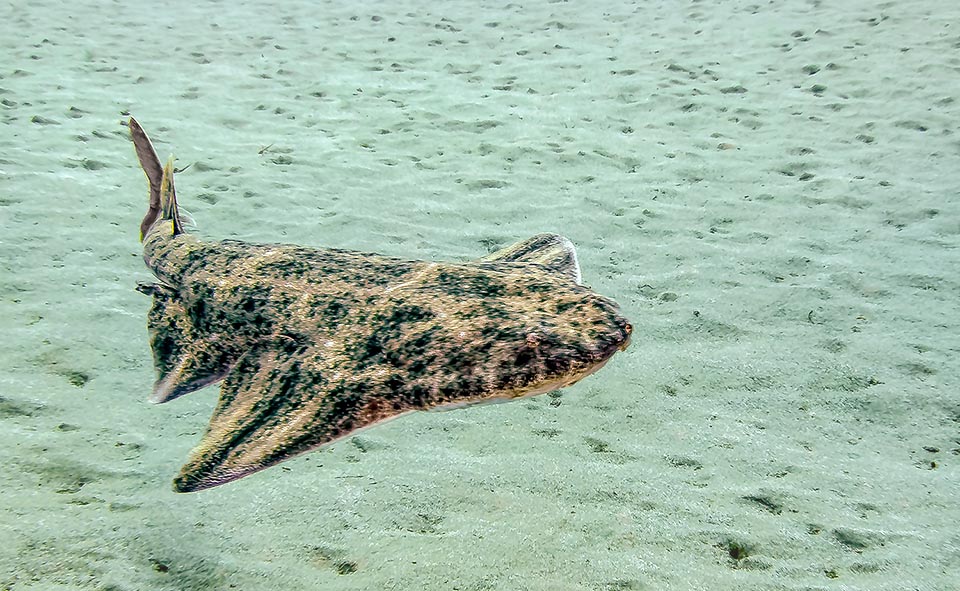
Squatina squatina can reach the length of 244 cm and 80 kg, but the current size is of about 150 cm. The dorsal livery is camouflaging © Lionel Houde
The adults’ livery varies from brown to greenish with irregular dark spots and marbled mottlings, whilst in the young is less dark with clear and dark lines and have on the back a row of protective spines.
Ethology-Reproductive Biology
The Angelshark is not aggressive towards divers, but, if disturbed, it swims around threateningly with its open mouth and may cause serious bites.
It eats fishes, molluscs and crustaceans, especially octopuses, rays and young sharks it seizes and gulps down whole.
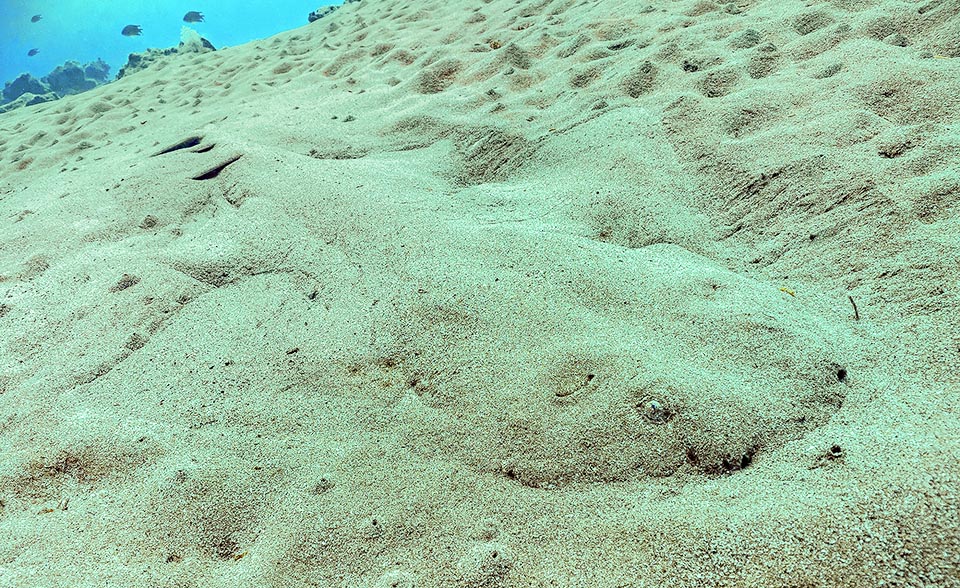
When then the shark covers with sand, it is practically invisible, but ready to jump on the preys also over time, as it hunts by night © Lionel Houde
In turn it is preyed upon by large sharks and annoyed by Stibarobdella macrothela, a 6-7 cm leech that often adheres to the body or ti the fins, but its worst foe is the man who has fished it too much and still fishes it with the trawl nets regardless of prohibitions, then peddling it on the markets as Monkfish.
The females are ovoviviparous and the growing larvae have all the necessary resources for their development thanks to their big yolk sac. Therefore, they must not devour their brothers as is the case of Carcharias taurus, where the strongest eats all others, or gnaw the unfertilized ova like Carcharodon carcharias and not even connect through a sort of placenta to the maternal blood vessels like Negaprion brevirostris or Sphyrna lewini.
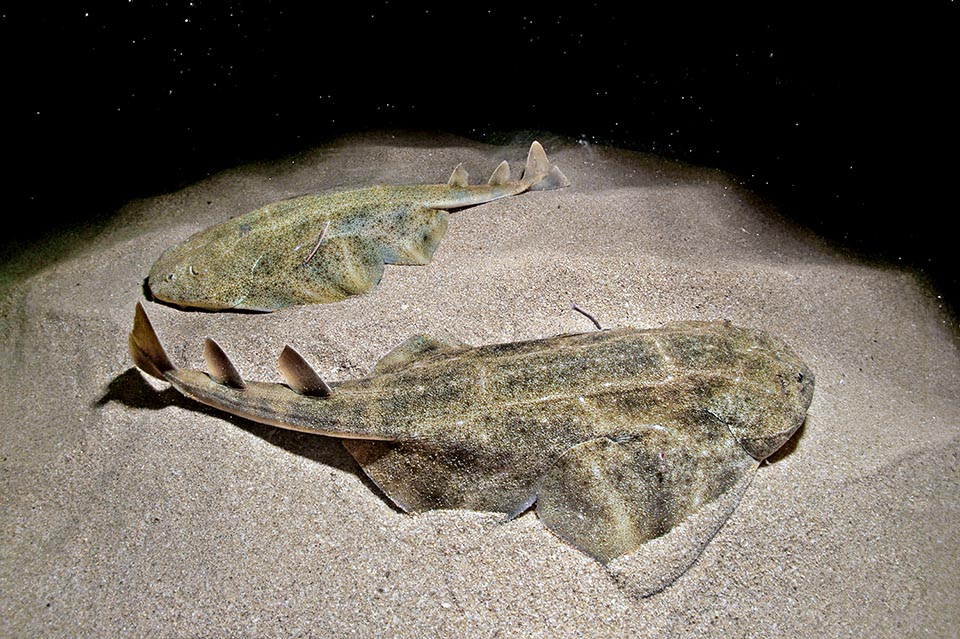
The females are ovoviviparous and deliver 7-12 infants every two years. The growing larvae have all the reserves needed for their development, due to the big yolk sac © Michael J Sealey
So, after an 8-10 month pregnancy, the females deliver, depending on their size, 7-22 infants that upon birth measure 24-30 cm.
Therefore, we might think that, compared to other sharks, this species is not endangered, but between one pregnancy and another the females need time for recovering strength and deliver then only every two years. For reproducing, the young must reach 125-170 cm and often end up before in a net or on the hook of a sport fisherman.
Consequently, their resilience is low, with a minimum time for doubling the populations of 4,5-14 years, and the fishing vulnerability index, unbelievably high, marks even 90 on a scale of 100.
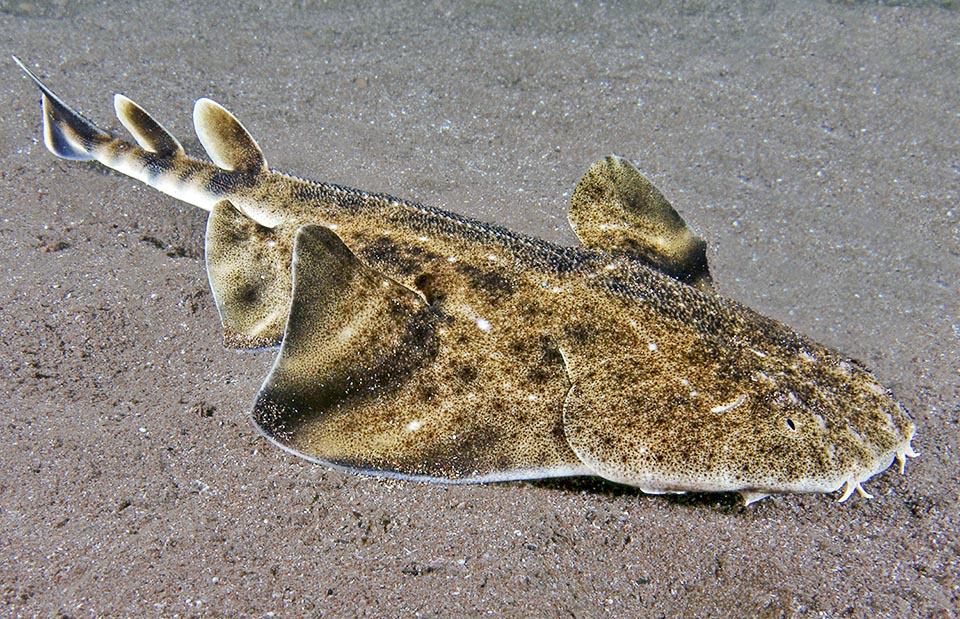
Juvenile livery is clearer with mimetic lines and a row of spines on the back. Too much fished, Squatina squatina is a “Critically Endangered” species, under risk of extinction © Michael J Sealey
Thus, nowadays Squatina squatina stands unfortunately at the maximum extinction risk in the Red IUCN List as “Critically Endangered”.
Conversely, the Angelshark may be hosted without too many difficulties in the big public aquaria. In that of Naples one specimen has lived 6 years, accidentally dying, killed by a big turtle.
Synonyms
Squalus squatina Linnaeus, 1758; Squatina vulgaris Risso, 1810; Squatina laevis Cuvier, 1816; Squatina angelus Blainville, 1825; Squatina lewis Couch, 1825; Squatina europaea Swainson, 1839; Squatina angelus Gronow, 1854.
→ For general information about FISH please click here.
→ For general information about CARTILAGINOUS FISH please click here.
→ For general information about BONY FISH please click here
→ To appreciate the BIODIVERSITY of CARTILAGINOUS FISH please click here.
→ To appreciate the BIODIVERSITY of BONY FISH please click here.
